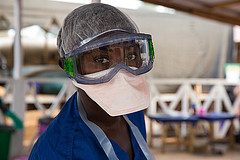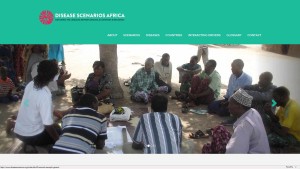 The Ebola epidemic alerted many to the interconnectedness of human, animal and environmental health. The medical community has traditionally lagged behind animal health and ecosystem experts in embracing One Health, the predominant movement espousing this approach, but now a report from a Lancet and Rockefeller Foundation co-convened Commission on Planetary Health appears to do so enthusiastically (even if not the term).
The Ebola epidemic alerted many to the interconnectedness of human, animal and environmental health. The medical community has traditionally lagged behind animal health and ecosystem experts in embracing One Health, the predominant movement espousing this approach, but now a report from a Lancet and Rockefeller Foundation co-convened Commission on Planetary Health appears to do so enthusiastically (even if not the term).
The report states that Planetary Health is “the achievement of the highest attainable standard of health, wellbeing, and equity worldwide through judicious attention to the human systems – political, economic, and social – that shape the future of humanity and the Earth’s natural systems that define the safe environmental limits within which humanity can flourish.”
One Health, or Planetary Health – or indeed EcoHealth or any of the other terms that have been used for a holistic approach to disease, is certainly gaining ever-greater recognition and traction. However, when it comes to zoonotic diseases, that rhetoric is only rarely translated into reality.
The Tripartite on One Health between the World Health Organization (WHO), the Food and Agriculture Organization (FAO) and the World Organization for Animal Health (OIE) has offered welcome One Health international leadership and coordination in the area of zoonoses. Still, cross-sectoral understanding, cooperation and political commitment have yet to be widely taken up at national and local levels.
This is despite another just-published report concluding that the knowledge and tools do now exist for the control of many neglected zoonotic diseases. What is needed is their large-scale implementation .
The following, drawn from a briefing from the STEPS-led Dynamic Drivers of Disease in Africa Consortium, Zoonoses: From Panic to Planning, outlines what now needs to be done and why:
1. Ringfence long-term funding
Too often crises-driven responses to zoonoses lead to the further neglect of endemic diseases. For example, during the recent Ebola epidemic attention shifted away from Lassa fever, a zoonoses that causes some 5,000 deaths a year in West Africa, and effects up to 300,000 others. Ringfenced resources need to be available to control and manage endemic zoonoses, such as Lassa fever, brucellosis and trypanosomiasis.
2. Plan for uncertainty
 Disease emergence is inherently uncertain. Even improved scientific modelling and surveillance can’t tell us everything we need to know. In many cases we don’t even know what we don’t know. Scenarios planning is one way to identify a range of possible futures, start discussion about a desirable future and help decision-makers and communities take action.
Disease emergence is inherently uncertain. Even improved scientific modelling and surveillance can’t tell us everything we need to know. In many cases we don’t even know what we don’t know. Scenarios planning is one way to identify a range of possible futures, start discussion about a desirable future and help decision-makers and communities take action.
3. Improve measurement and mapping
There is massive under-reporting and mis-reporting of zoonoses with, in particular, many fever-causing diseases such as brucellosis and trypanosomiasis being wrongly attributed to malaria. Better measuring and mapping of zoonoses is key to helping decision-makers plan and manage disease control. It will also help identify disease hotspots and pinpoint diseases to be prioritised.
4. Improve surveillance
Surveillance and monitoring allow for better planning. But they need to shift from a focus on a disease or specific event to a focus on the whole system, looking at interactions between disease drivers and disease incidence at the community level. They also need to look at the poverty and equity impacts. Such systemic surveillance approaches require new organisational arrangements, diverse expertise and the direct involvement of local people affected by disease.
5. Introduce more flexible and collaborative ways of working
Zoonoses often fall through the gaps of different disciplines and sectoral responsibilities. Formalising cross-sector work at national and local levels can make for better preparedness and contingency planning, more efficient and effective surveillance systems for diseases, and improved sharing of logistics and costs. Collaboration such as Kenya’s Zoonotic Disease Unit lead the way.
6. Use local expertise
Complex processes such as disease emergence where outcomes are uncertain require multiple sources of expertise. Very often in remote areas, without public health and veterinary coverage, it is local people who know most about disease dynamics and impacts. Adding participatory approaches into the mix can lead to new understandings and strategies for dealing with disease.
7. Develop justice and rights-based approaches
Zoonotic diseases have a disproportionate impact on the poor and often the impacts of control measures can exceed the costs of disease. For example, movement restrictions on livestock as a way of controlling disease can be disastrous for poor people if they can no longer take their animals to market. Assessing the costs of disease intervention and control is a must. Equally, issues of access to disease prevention and control measures should be thought through.
It is good to see more of the medical community embracing holistic approaches to disease. To make One Health a reality, it will take all those interested in disease control – from human and animal health experts to ecosystem and wildlife specialists to medical anthropologists and health economists – to make things happen.
-
Discuss translating One Health rhetoric into reality by registering for One Health for the Real World: zoonoses, ecosystems and wellbeing.
-
Find out more about the Dynamic Drivers of Disease in Africa Consortium.
-
Find out about Livestock, Livelihoods and Health, another programme in which STEPS researchers are exploring zoonoses.